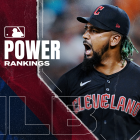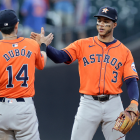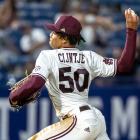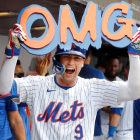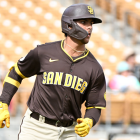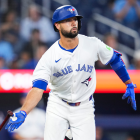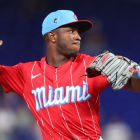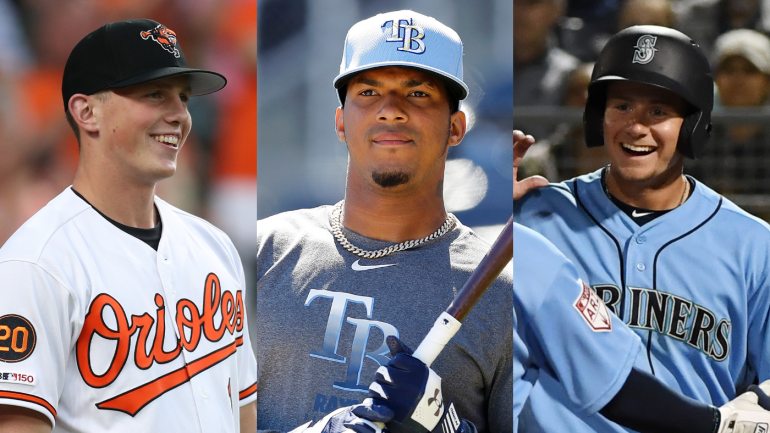
We've spent part of the offseason ranking the top five prospects for every MLB team. Now that that process is finished and spring training has started, we've opted to rank the top 50 prospects in all of baseball. You'll find the players listed below in order of their perceived impact with other factors -- like their riskiness -- baked in. You'll also find our report on each player.
Do note that 50 is, itself, an arbitrary figure -- and that his is more art than science. Any number of players could have cracked the bottom of the list without it being a big deal, and if you prefer the prospect ranked No. 32 to the prospect ranked No. 35, that's fine with us.
Note that, unlike with our team-oriented prospect lists, which made adjustments only in the events of a graduation or a new addition, we've decided to actively rerank the top 50. In other words, there are some new names and some new faces in new places here based on what happened during the 2020 calendar year. (That also explains why there might be some discrepancies when compared to the team lists themselves.)
Anyhow, onto the top 50 prospect rankings entering the 2021 season.
1. Wander Franco, SS, Rays
Scouting report: Franco is a switch-hitter who makes a ton of contact, much of it hard; he garners above-average marks for his speed and his arm; and ... look, there's just not much he can't do. One rival front-office member said that Franco could've probably held his own in the majors back in 2019, when he was an 18-year-old. He has a chance to be a special, special player -- it's just a matter of when the Rays elect to bring him up. Our guess would be after the Super Two deadline.
WanderVision pic.twitter.com/Gk7jHs3U77
— Tampa Bay Rays (@RaysBaseball) March 3, 2021
2. Adley Rutschman, C, Orioles
Scouting report: Rutschman has the potential to graduate with plus grades for every tool except speed -- and remember, he's a catcher, so that's almost irrelevant. He's a switch-hitter with similar swings and skill sets from both sides. Rutschman has a good eye; the strength to hit for power; and the bat control and barrel awareness to collect a solid average. Defensively, he grades well as a receiver; he has a strong arm; and he has the makings of being a field general. You almost have to go looking for knocks against him. Even then, the biggest blemishes are ... his 12 games' worth of struggles in A-ball? His past medical concerns that no longer seem relevant? How about the fact that he probably doesn't play for your favorite team? He's going to be good, very good, and he should reach that ceiling sooner than later.
3. Jarred Kelenic, OF, Mariners
Scouting report: Kelenic probably would've made his big-league debut in 2020 with a normal season. Alas, he'll have to wait until 2021. Kelenic has the means to make up for lost time; he's an advanced hitter who should contribute across the triple-slash categories. He has a simple, in-control swing that nonetheless permits him to generate easy, above-average power. Kelenic isn't going to win a Gold Glove in center field, in all likelihood, but he's playable there and may improve. As an added bonus, he should be able to steal a handful (or two) of bases a year as well.
4. Julio Rodriguez, OF, Mariners
Scouting report: Rodriguez will almost certainly be the top prospect in the M's system this time next year. He has the makings of becoming a middle-of-the-order fixture who hits for average and big-time power alike thanks to his bat speed, strength, and feel for making loud contact. Rodriguez split the 2019 season between A- and High-A and, despite being several years younger than his competition, hit .326/.390/.540 in what was his stateside debut. Defensively, he's likely heading for permanent residence in right field, where his well-above-average arm should help him atone for whatever range he may lose in time as he adds weight to his frame.
5. Sixto Sanchez, RHP, Marlins
Scouting report: Sanchez was arguably the most exciting individual aspect of the Marlins' season. He started seven times, amassing a 3.46 ERA and a 3.00 strikeout-to-walk ratio in 39 innings. The biggest concerns with Sanchez's game entering the year were his size and his fastball's effectiveness -- despite good velocity, he'd never missed bats as expected. Sanchez will have to string together some 30-start seasons to fully put the former to concern; he did miss bats with his heat in the seven-game stretch, though opponents batted .368 against his sinker. In other words, the jury might still be out. Given the topline results, it might not matter.
Sixto Sánchez, 100mph Fastball, 89mph Changeup and 88mph Slider, Overlay with Tails. pic.twitter.com/WUBCfjaDyL
— Rob Friedman (@PitchingNinja) August 29, 2020
6. Ian Anderson, RHP, Braves
Scouting report: Anderson has already achieved big-league success. In six starts, he averaged more than five innings while posting a 1.95 ERA and a 2.93 strikeout-to-walk ratio. Anderson seldom allowed hard contact, and he instead missed a lot of bats with a three-pitch mix: mid-90s fastball; high-grade change; and a low-spin curve. Anderson did throw fewer strikes than you'd like, but his ability to limit contact negates some of the ill effects of his walk rate. He should remain a key member of the Braves rotation, and ought to settle as a No. 2 or 3 starter.
7. MacKenzie Gore, LHP, Padres
Scouting report: It seemed likely that Gore would make his big-league debut at some point during the 2020 season, the way two other members of the Padres' top five did. Yet Gore never did get the call, and instead spent the year at the alternate site. Rest assured, he'll get his, and sooner than later. Gore checks all the boxes one could want in a potential frontline starter: he's athletic; he should have multiple plus offerings; and he should have above-average command. He's a pitcher, so some kind of injury could pop up and ruin everything. Shy of that, Gore is probably going to have a long and successful career, beginning in 2021.
8. C.J. Abrams, SS, Padres
Scouting report: Abrams is one of the fastest players in organized baseball. That could come in handy on defense if he's forced to move away from shortstop, perhaps to center. It also comes in handy on offense, but Abrams is more than a Billy Hamilton facsimile. He has a good feel for contact and above-average power potential thanks to a projectable frame. There's real star-level potential here, depending on how Abrams matures over the coming years.
9. Cristian Pache, OF, Braves
Scouting report: Pache is a dynamic center fielder who should be making highlight reels and best-of lists with his wheels and his arm for the next half-decade, at minimum. He could grow into a good baserunner, too, provided he becomes more efficient as a thief. That combination ought to grant him a wide berth at the plate -- he might need it, too. Pache has a pull-happy approach and swings and misses a lot, to the extent that it could limit his batting average. To his credit, he has improved his walk rate, and he's had stretches where he's been able to tap into his raw power. Any kind of sustained offensive improvements would make him a star-caliber player. Shy of that, he's probably going to grow into the new Jackie Bradley Jr. or Kevin Kiermaier.
10. Ke'Bryan Hayes, 3B, Pirates
Scouting report: Hayes is already a high-quality defensive third baseman. His movements are fluid, his hands are soft, his arm is plus, and his range is such that he's going to make a habit out of intercepting grounders and choppers ticketed for the shortstop. (One source pondered if Hayes could cut it at shortstop.) His offensive value is tougher to pin down. Hayes hit double-digit home runs for the first time last year in Triple-A, but that was rabbit-ball-assisted and he did so while providing below-average production overall. He should walk a fair amount, and his above-average speed gives him a chance for a dozen-plus steals. Everyone hits for power these days, though, and Hayes' bat could play a touch light.
11. Dylan Carlson, OF, Cardinals
Scouting report: The switch-hitting Carlson appeared in 35 big-league games, batting just .200/.252/.364 with a 29.4 percent strikeout rate. There's ample reason to think he'll put that disappointing stretch behind him sooner than later, beginning with his relative youth and his well-rounded offensive skill set. Carlson has a disciplined approach; ample bat speed; and above-average raw strength. There's a chance he trades some contact for power; otherwise, he should be able to contribute to each of the triple-slash line stats. The Cardinals used him a fair amount in center field in 2020, but he might outgrow that as he ages. Carlson is also regarded as a hardworker who's a good bet to max out his physical skills.
12. Casey Mize, RHP, Tigers
Scouting report: Mize's first tour of duty in the majors didn't go as well as expected. The Tigers limited him to 20 batters or fewer in all but one of his seven outings, yet he still accumulated a 6.99 ERA with suboptimal peripherals to match. Mize's splitter, his signature offering, wasn't all that effective as an out pitch: opponents hit .313 against it and by year's end he was throwing it less and less frequently. There's no sense overreacting to a small sample during a plague year, but it's fair to write that Mize disappointed. He'll get another shot in '21.
13. Brendan McKay, LHP/1B, Rays
Scouting report: McKay was supposed to be a safe mid-rotation starter with good command, poise, and stuff. (Scouts weren't as high on his bat.) Alas, he had a miserable 2020. First he missed time because of COVID-19, and then because of shoulder surgery. It's unclear how McKay will bounce back -- obviously the hope is that he looks as though he never missed a day -- but it just goes to show that there might not be such a thing as a safe pitching prospect.
14. Bobby Witt Jr., SS, Royals
Scouting report: There's no questioning Witt's physical gifts. He can move and throw well enough to stick on the left side of the infield, and he has the size and strength to project for 20-plus-homers at his peak. If he lives up to his promise, he could well become a star-level producer. Yet there were some valid criticisms that made him a polarizing prospect heading into the 2019 draft. Namely, Witt was older than the average prepster, and he had a history of swinging and missing -- a concern because it suggests he might have problems against pro competition. Calling him a boom-or-bust prospect overstates things, but it gets the point across that there's significant upside and downside present in his game.
15. Marco Luciano, SS, Giants
Scouting report: Luciano, who won't turn 20 until next September, will probably head this list next year -- and maybe for a few more after that. He has star-level upside thanks to a projectable frame; great bat speed; and natural loft. His defensive home is to be determined -- he's probably not sticking at shortstop and may have to slide to the outfield, depending on how his body matures -- but it almost doesn't matter. All the tools are here for an impact-level hitter. It's just a matter of him getting the necessary repetitions, staying healthy, and developing on schedule.
💥 Marco Luciano 💥 pic.twitter.com/hhMBjw5NxL
— SFGiants (@SFGiants) July 8, 2020
16. Nolan Jones, 3B, Cleveland
Scouting report: It was a little surprising that Cleveland, who badly needed offense throughout the year, never gave Jones a look at big-league pitching. He has the potential to be an above-average contributor at the dish thanks to his command over the strike zone and his above-average strength. Alas, Cleveland left him at the alternate site, where he ostensibly worked on his third-base defense (he might have to move off the position) and his ability to make more consistent contact (he struck out in roughly 30 percent of his Double-A plate appearances in 2019). There's no reason to think Jones won't debut in 2021.
17. Kristian Robinson, OF, Diamondbacks
Scouting report: Robinson is one of the most intriguing prospects in the game. He possesses above-average raw power and speed, and his projectable frame should allow him to add more muscle. He's athletic enough to play center field for the time being, though any added weight could force him into a corner (likely right given that he has a strong arm). Robinson does swing and miss a lot, and he'll have to be mindful of striking out as he ascends the minors. The absolute ceiling here is star-level. It's anyone's guess as to whether he gets there.
18. Nolan Gorman, 3B, Cardinals
Scouting report: Gorman's profile can be summed up easily: boom or bust. He has loud, loud raw power and loud, loud swing-and-miss issues. In 2019, he punched out in roughly 30 percent of his plate appearances split between two levels, all the while posting an ISO north of .190. Gorman isn't going to contribute a ton of value on the defensive side of things, meaning everything will boil down to whether he makes enough contact to be productive. His age and track record suggests he will, but it's too early to say for certain.
19. Austin Martin, CF/INF, Blue Jays
Scouting report: Martin entered last year's draft ranked as our No. 1 prospect in the draft thanks to his broad skill set. He has a mature approach at the plate and quality bat-to-ball skills that made him the toughest hitter in a power conference to strike out. Additionally, Martin's exit velocities suggest there might be above-average raw power in his bat to tap into. He runs well and runs smart, and he's a versatile defender -- at least in the sense that he can stand-in at short, second, third, and in center. The latter might be his permanent landing spot, though it would fit with the modern era if the Blue Jays have Martin play a little bit of everywhere.
20. Andrew Vaughn, 1B, White Sox
Scouting report: Vaughn is comparable in many ways to Spencer Torkelson, the No. 1 pick in the 2020 draft. They're both right-handed first basemen from the west coast who have all the tools -- eye, bat speed, strength, feel for contact and making adjustments -- and who should move quickly through the minors before taking their rightful spots in the middle of an order. On that note, there's a fair chance Vaughn will make his big-league debut before the year is over.
21. Spencer Torkelson, 1B, Tigers
Scouting report: Torkelson became the first collegiate first baseman to ever go No. 1 when the Tigers popped him out of Arizona State (they announced him as a third baseman at the time). While it's fair to have reservations about almost any and every right-handed first baseman, there's a lot to like here. He has the bat speed, strength, and barrel control to hit balls long and hard; the approach to accept walks and keep his strikeout rate in check; and the mind to make on-the-fly adjustments to his swing or gameplan. Torkelson probably won't add a ton of value positionally or on the basepaths; he won't have to in order to be a quality part of a lineup.
22. Asa Lacy, LHP, Royals
Scouting report: Lacy seemed like the favorite to become the first pitcher taken in June, and there was a reasonable case to be made that he could've been the top pick overall. The Royals, then, had to be thrilled that he was available to them at No. 4. Lacy's fastball-slider pairing jumps out whether one is using the eye test or a Trackman machine, and he has both the frame and the demeanor that teams look for in their frontline starters. What Lacy doesn't have, at present anyway, is top-notch command. If the Royals can help him locate more consistently, he could outpace the below projection. Otherwise, his future could look similar to Robbie Ray's past: a volatile mid-rotation starter who fluctuates between dominant and not.
23. Alex Kirilloff, OF, Twins
Scouting report: Kirilloff made his big-league debut during the playoffs, going 1 for 4 in the Twins' Wild Card Series loss against the Astros. Expect him to get hundreds of more plate appearances during the 2021 season, and expect him to do far more damage. Kirilloff has the potential to hit for average and power, which will be more pivotal to him than the standard high-ranked hitting prospect: he's never walked in as much as nine percent of his plate appearances as a professional. Defensively, Kirilloff has enough arm strength to man right, though he could end up sliding to first base on a permanent basis as he matures.
24. Heliot Ramos, OF, Giants
Scouting report: Ramos isn't going to stick in center field. What he is going to do, in all likelihood, is hit for power. Ramos did see his K rate spike to over 30 percent during a 25-game stint in Double-A -- about six percentage points higher than his High-A rate. It's only fair to give him a chance to make adjustments before raising the red flag; that established, it's difficult to be a consistently above-average big-league hitter when you're striking out that frequently.
25. Royce Lewis, SS, Twins
Scouting report: Lewis entered the 2019 season in contention for the title of "baseball's best prospect (other than Wander Franco)." Unfortunately, he had a rough season. He didn't take well to a swing change, leaving him out of whack for much of the year. He also didn't look any better at shortstop, suggesting his long-term defensive home might be in center, where his speed could make him an asset. Lewis is still young and talented enough to give another year, but there's far more risk associated with him and his profile than it seemed just two years ago. [Ed note: Lewis tore his ACL earlier this spring and will likely miss the season.]

Fantasy Baseball Draft Kit
Your ultimate baseball draft guide
Dominate your Fantasy Baseball draft with our free Draft Kit, which gives you must-have positional and Top 300 rankings in a printable format. Plus track your draft with our lineup builder and salary cap tracker.
Thanks for signing up!
Keep an eye on your inbox.
Sorry!
There was an error processing your subscription.
26. Michael Kopech, RHP, White Sox
Scouting report: Kopech appeared to have made significant strides with his command before making his big-league debut in 2018. He then tore his UCL after four starts, causing him to miss the entire 2019 season in the process. Kopech was supposed to be a big part of Chicago's rotation plans this year, but he opted out of the season before it started, leaving him more than two years removed from his last meaningful pitch. Kopech has top-notch stuff; there's just too much riding on his command to feel confident projecting more than a mid-rotation arm for now.
So happy to see Michael Kopech back in action! pic.twitter.com/lWbbdjt69o
— Chicago White Sox (@whitesox) March 10, 2020
27. Grayson Rodriguez, RHP, Orioles
Scouting report: Rodriguez is a large, physical right-hander who wouldn't look out of place if he started a big-league game tomorrow. He has two high-quality pitches in his fastball and breaking ball, and a developing changeup that at last check had one of the largest velocity gaps in professional baseball. Rodriguez will have to continue to work on smoothing out his delivery, as is often the case for high-school draftees with 113 innings, but there's a lot to like here and it shouldn't come as a surprise if someday down the road he occupies the top spot in the system.
28. Matt Manning, RHP, Tigers
Scouting report: There was an argument to be made last winter that Manning should have been the No. 1 prospect in Detroit's system based on his cleaner bill of health. Naturally, what with the law of attraction and whatnot, Manning missed his chance at debuting this season because he was sidelined by a strained forearm -- often a precursor to Tommy John surgery. If Manning can avoid surgery or a prolonged setback, he ought to plant his flag in the majors in 2021. He has a good fastball-curveball combination and he has made strides with his changeup. Add in his frame and athleticism, and maybe he'll end up being better than Mize after all.
29. Luis Patino, RHP, Rays
Scouting report: Patino had an eventful, if not particularly memorable rookie season. He was optioned to the alternate site three times during the month of September, limiting him to 11 regular-season appearances. In those outings, he allowed 10 runs on 18 hits and 14 walks. Patino is on the smaller side, but he has big-time stuff, including an above-average fastball and breaking ball. Patino still needs to work on his changeup and his command; provided he makes progress -- do note his age -- he should get a chance as a mid-rotation starter. Otherwise, he has a promising future in relief, where his size wouldn't be talked about as frequently.
30. Shane Baz, RHP, Rays
Scouting report: Baz has three potential plus pitches, his fastball, curve, and cutter, and has the body to start. His delivery leaves him with so-so command, and he's had issues with left-handed batters because of his lagging changeup. The upside is considerable, but there's a real chance he ends up in the bullpen if he can't shore up those weaknesses over the coming years.
31. Deivi Garcia, RHP, Yankees
Scouting report: Garcia made his big-league debut in 2020, compiling a 4.98 ERA and a 5.50 strikeout-to-walk ratio across six regular season starts. He later became the youngest Yankees pitcher to start a postseason contest since Whitey Ford. That's a nice little beginning to a career, huh? Garcia has the stuff and the athleticism to start -- his curveball is likely to be subject to many GIFs -- but his size is going to be held against him until he's able to string together high-quality outings. Garcia is capable of delivering just that, and for the time being the Yankees seem committed to giving him the opportunity.
32. Brandon Marsh, OF, Angels
Scouting report: Marsh may have reached the majors in 2020 under normal conditions. Unfortunately, he was placed on the 10-day injured list upon reporting in July, and he never received the opportunity to debut. Marsh has an ample amount of secondary skills: he's a good outfielder with a strong arm who should also contribute on the basepaths (he's stolen 43 bases on 54 attempts for his career). The biggest question he faces is with his bat. Marsh hasn't been able to tap into his raw power on a consistent basis, and he might have to settle for putting the ball on the turf and leveraging his wheels more than you'd expect from someone with his size.
33. JJ Bleday, OF, Marlins
Scouting report: There isn't a ton to nitpick here. Bleday performed at a high level against top-level competition in college. He has all the tools (bat, feel for hit, arm strength) to suggest he's going to be a quality two-way contributor at the big-league level, likely out in right field. And so on. Perhaps the biggest problem with Bleday is the thing that's out of his control: the pandemic delayed his arrival to the upper-minors, which, in turn, will likely delay his big-league debut. Don't forget about Bleday, though: he has a chance to be a good one.
34. Alek Thomas, OF, Diamondbacks
Scouting report: As we noted last year, the main questions with Thomas are where he'll end up defensively and how much power he'll grow into. Because Thomas doesn't have a strong arm, the answer to the first part is either center or left field. As for the second part, it's important because the difference between the Sam Fulds and the Brett Gardners of the world is their ability to burn pitchers' mistakes. Without that, big-league arms are more likely to challenge them, to the extent that it suppresses their batting average and on-base percentage. Presuming Thomas does show enough pop to keep pitchers honest, he ought to be a top-of-the-order hitter and a decent to good glove wherever he lands on the grass.
35. Logan Gilbert, RHP, Mariners
Scouting report: The Mariners have taken a collegiate starter in each of the last three drafts. Gilbert, at present anyway, appears to be the closest to the majors. He closed the 2019 season with nine Double-A starts, during which he amassed a 2.88 ERA and a 3.73 strikeout-to-walk ratio. Gilbert has an inning-eating frame to go with a good fastball and three secondary pitches that fluctuate between average and slightly above or below. With a touch more consistency, he could take a step forward. Whatever the case, he's likely to debut in 2021.
Logan Gilbert vs. Jarred Kelenic to start the day 🔥
— Tacoma Rainiers (@RainiersLand) August 30, 2020
Full at-bat ⤵️ pic.twitter.com/iqmwyCpNwZ
36. Josiah Gray, RHP, Dodgers
Scouting report: Gray barely pitched until his junior year at Le Moyne. Once he showed promise with the Reds in rookie ball, the Dodgers quickly pounced on him, adding him in a multi-player deal. Gray has since progressed into a legitimate rotation option, and one who could debut in 2021. He has a promising three-pitch mix and more control than you'd expect from someone still relatively new to the craft. It's at least possible that Gray continues to make strides, even as he gets into his mid-20s, because of his athleticism and his circumstances.
37. Drew Waters, OF, Braves
Scouting report: As if the Braves needed another young outfielder ... Waters is a switch-hitter with a ton of physical gifts: he runs and throws well, and he has above-average power potential. Waters has seen his strikeout rate shoot up since reaching the upper minors, to the extent that he fanned in nearly 40 percent of his plate appearances in 26 Triple-A games. That's too small a sample to get overly worked up about, but it is something worth monitoring -- especially since it could prevent him from reaching his upside as a well-rounded regular.
38. Keibert Ruiz, C, Dodgers
Scouting report: Ruiz has one of the odder profiles you'll see at any position, let alone backstop. He's an extreme contact hitter who has fanned in less than 10 percent of his plate appearances dating back to 2018. Those impressive bat-to-ball skills form the backbone of his game. Ruiz does have average raw power, though it hasn't often shown up in games. There's a real chance he's a singles-heavy hitter who's average or better behind the plate. That should be enough to start, and, more trivially, to stand out among the crowd.
39. Nick Lodolo, LHP, Reds
Scouting report: Lodolo was the first pitcher off the board in 2019 thanks to an athletic, repeatable delivery; a solid three-pitch mix; and a David Price-like frame that should enable him to shoulder big-league workloads. Lodolo lacks the top-end stuff that would enable him to be a front-of-the-rotation starter, but that shouldn't prevent him from having a career as an above-average starter.
40. Emerson Hancock, RHP, Mariners
Scouting report: Hancock was the third collegiate pitcher to come off the board in June, behind Max Meyer and Asa Lacy. There's no shame in that, though it speaks to the nature of his profile that other teams opted for pitchers with upsides that were perceived to be higher. Hancock is a strikethrower with three above-average average or better secondary offerings, making it easy to foresee him latching on as a No. 3 starter with minimal development. There are some within the game who believe there's additional upside to unlock with Hancock's arsenal. If that proves to be the case, he might end up as a No. 2 starter -- and a relative steal.
41. Max Meyer, RHP, Marlins
Scouting report: Meyer was the first pitcher off the board in June, a surprise given that he seemed likely to go after Asa Lacy and Emerson Hancock -- or, two taller pitchers from more prestigious programs. Meyer deserves the flowers: he has a big-time fastball-slider combination and more than enough athleticism to stick in a rotation despite his modest frame. He'll just need to work on his changeup to ensure that remains the case.
42. Ronny Mauricio, SS, Mets
Scouting report: Zora Neale Hurston once wrote that ships at a distance have every man's wish on board. Teenage shortstops are often the baseball equivalent of that. That's especially true of those like Mauricio. He has oodles of athleticism; a tall, lanky frame that he could add weight to, giving him above-average power; plenty of dexterity (he's a switch-hitter); some established aptitude against pro-caliber pitching; and, potentially, an All-Star ceiling. Whether or not Mauricio gets there -- and whether or not he sticks at short or has to slide elsewhere, possibly to third -- is a ways off. For now, he's a dot on the horizon. And it's hard to look away.
43. Zac Veen, OF, Rockies
Scouting report: Veen was the second prep bat taken in June's draft; he could've been the first. He's a long, lean left-hander who's certain to draw Kyle Tucker comparisons from now until the time he makes his big-league debut. All the makings of a run producer are present. He has ample bat speed; he has a keen eye; and he has a projectable frame that ought to allow him to add weight and strength over the coming years. The only hiccup there is that Veen will likely have to slide off center as he grows. Oh well. He has enough arm to man right.
44. Matthew Liberatore, LHP, Cardinals
Scouting report: The key to the Randy Arozerana trade, so far as the Cardinals are concerned, Liberatore has a chance to become an above-average starter thanks to his above-average sinker and well-above-average curveball. He's likely to be more of a contact manager more so than a strikeout artist once he reaches the majors. That's okay; the Cardinals seem to be one of the few organizations who are still on board with sinkerballer types. Liberatore generated nearly 60 percent grounders against A-ball competition in 2019, which bodes well for his future.
45. Josh Jung, 3B, Rangers
Scouting report: Despite being selected eighth overall, Jung (it's pronounced "young") was the fourth collegiate bat off the board in 2019. Based on that sentence, you might suspect that he's a polished hitter who is reasonably likely to remain at his position; true on both accounts. What you might not guess is that he could lack a carrying tool unless he's able to maximize his offensive output by tapping into his raw power. Should Jung fail in that pursuit, he'll have a handful of averageish tools, which isn't the worst-case scenario -- that would entail his power playing so light as to diminish his potential to hit for average and walk at a high clip.
46. Mick Abel, RHP, Phillies
Scouting report: It takes a lot for a right-handed prep arm to go early in the draft. In that sense, it shouldn't have been too surprising that Abel slid to the Phillies despite possessing a high upside. He has everything you could want in a young pitcher: a strong frame; three budding pitches; athleticism; and projectability. There's risk that he gets hurt or doesn't develop as hoped, of course, but there's also a chance he turns into one of the better values of the 2020 draft.
47. Garrett Crochet, LHP, White Sox
Scouting report: Crochet's professional debut came in the form of his big-league debut. He appeared in five regular-season games and a postseason game, showing off triple-digit velocity and an occasional swing-and-miss slider. Unfortunately, Crochet left his final appearance with an injury, which is a common theme for him. He made just one start before the college season was shuttered because of a physical issue, and other teams had reservations about his medicals during the draft process. There's no denying Crochet's impressive raw stuff -- he just might have to make his impact in a relief role if his body doesn't hold up under a starter's workload.
48. Forrest Whitley, RHP, Astros
Scouting report: Whitley entered the 2019 season in the conversation for the title of "best pitching prospect in baseball." He then had a hellacious year that saw him post a 7.99 ERA and walk more than six batters per nine in 59 innings. To make matters worse, he's never thrown as many as 100 innings in a season because of the pandemic, injuries, and suspension. Whitley has a deep, high-grade arsenal and the frame to eat innings. Whether he ever lives up to his billing as a potential front-of-the-rotation monster is anyone's guess. The way things have trended, it would be fair to say that it seems unlikely.
I have to say, #Astros prospect Forrest Whitley looks ready to go... more on this soon in this week’s @MLBPipeline Inbox! Stay tuned.... pic.twitter.com/w2JBqEXXch
— Jonathan Mayo (@JonathanMayo) May 28, 2020
49. Corbin Carroll, OF, Diamondbacks
Scouting report: As stupid as it sounds, if Carroll were a few inches taller he would probably be held in higher regards in prospecting circles. Instead, he seems likely to be underrated until he gets closer to the Show. That's a shame because there's enough precedent out there -- be it Mookie Betts, Andrew Benintendi, or Adam Eaton -- to prove that smaller outfielders can perform at a high level. Carroll, for his part, can run and should stick in center field over the long haul; at the plate, he profiles as a well-rounded batter who'll hit for average, walk, and yes, produce stronger power numbers than you might expect at first glance. There's a lot to like here, in other words, and discounting him based on his size is a mistake.
50. Jasson Dominguez, OF, Yankees
Scouting report: The Yankees handed Dominguez, nicknamed "The Martian" because of his uncommon physical gifts, more than $5 million to sign with them in July 2019. He hasn't yet made his official professional debut, but he has inspired several small social media frenzies whenever a video or photograph is posted of his physique. There's almost no way Dominguez is going to live up to the hype, but he deserves the chance to develop into a good player.










